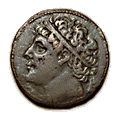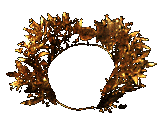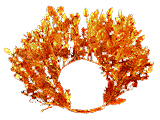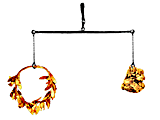![]() Introduction
Introduction![]() Sources
Sources

| Back to . . . | This section . . .
|
 Hiero II 306?-215 BC  Golden wreath from Amphipolis, Macedonia Fourth century BC  Golden wreath from Derveni, Macedonia Fourth century BC  Golden wreath from Vergina, Macedonia Fourth century BC  The wreath and the gold nugget have equal weight  The wreath displaces more water than the gold nugget |
In the first century BC the Roman architect Vitruvius
related a story of how Archimedes uncovered a fraud in the manufacture of
a golden crown commissioned by Hiero
II, the king of Syracuse. The crown (corona in Latin) would
have been in the form of a wreath, such as one of the three pictured from
grave sites in Macedonia. Hiero would have placed such a wreath on the
statue of a god or goddess. Suspecting that the goldsmith might have
replaced some of the gold given to him by an equal weight of silver, Hiero
asked Archimedes to determine whether the wreath was pure gold. And
because the wreath was a holy object dedicated to the gods, he could not
disturb the wreath in any way. (In modern terms, he was to perform
nondestructive testing). Archimedes' solution to the problem, as described
by Vitruvius, is neatly summarized in the following excerpt from an advertisement:
The solution which occurred when he stepped into his bath and caused it to overflow was to put a weight of gold equal to the crown, and known to be pure, into a bowl which was filled with water to the brim. Then the gold would be removed and the king's crown put in, in its place. An alloy of lighter silver would increase the bulk of the crown and cause the bowl to overflow.Although theoretically sound, this method has been criticized for several reasons. First, in spite of Vitruvius' s description of it as "the result of a boundless ingenuity", the method requires much less imagination than Archimedes exhibits in his extant writings. Second, it does not make use of Archimedes' Law of Buoyancy or his Law of the Lever. Third, and most important, it would be difficult to implement Vitruvius's method with the degree of measurement accuracy available to Archimedes. The third point needs some amplification. The largest known golden wreath from Archimedes' time is the one pictured from Vergina. It has a maximum rim diameter of 18.5 centimeters and a mass of 714 grams, although some of its leaves are missing. For the purposes of illustration, let us assume that Hiero's wreath weighed 1000 grams and that a container with a circular opening of diameter 20 centimeters was used. The opening would then have a cross-sectional area of 314 square centimeters. (All calculations are performed to three significant figures.) Because gold has a density of 19.3 grams/cubic-centimeter, 1000 grams of gold would have a volume of 1000/19.3 = 51.8 cubic-centimeters. Such a quantity of gold would raise the level of the water at the opening of the container by 51.8/314 = 0.165 centimeters. Next, suppose the dishonest goldsmith replaced 30% (300 grams) of the gold in the wreath by silver. Silver has a density of 10.6 grams/cubic-centimeter and so the gold-silver crown would have a volume of 700/19.3 + 300/10.6 = 64.6 cubic-centimeters. Such a crown would raise the level of the water at the opening by 64.6/314 = 0.206 centimeters. The difference in the level of water displaced by the wreath and the gold is thus 0.206 minus 0.165 centimeters, or 0.41 millimeters. This is much too small a difference to accurately observe directly or measure the overflow from considering the possible sources of error due to surface tension, water clinging to the gold upon removal, air bubbles being trapped in the lacy wreath, and so forth. Additionally, the change in water level would be even less than 0.41 millimeters if the wreath had a mass of less than 1000 grams, or if the diameter of the container opening were larger than 20 centimeters, or if less than 30% of the gold were replaced with silver. A more imaginative and practical technique to detect the fraud is the following, which makes use of both Archimedes' Law of Buoyancy and his Law of the Lever. Suspend the wreath from one end of a scale and balance it with an equal mass of gold suspended from the other end. Then immerse the suspended wreath and gold into a container of water. If the scale remains in balance then the wreath and the gold have the same volume, and so the wreath has the same density as pure gold. But if the scale tilts in the direction of the gold, then the wreath has a greater volume than the gold, and so its density is less than that of gold. It must then be a alloy of gold and some lighter material. To check the practicality of this technique let us again assume a 1000-gram wreath which is an alloy of 70% gold and 30% silver. Because its volume is 64.6 cubic centimeters, it displaces 64.6 grams of water. (Water has a density of 1.00 gram/cubic-centimeter.) Its apparent mass in water is thus 1000 minus 64.6 grams, or 935.4 grams. Next, 1000 grams of pure gold has a volume of 51.8 cubic centimeters, and so its apparent mass in water is 1000 minus 51.8 grams, or 948.2 grams. Thus, when both ends of the scale are immersed in water, there is an apparent mass of 935.4 grams at one end and an apparent mass of 948.2 grams at the other end, an imbalance of 12.8 grams. Scales from Archimedes' time could easily detect such an imbalance in mass. Additionally, sources of error arising with Vitruvius's method (surface tension and clinging water) would not arise with this scale method. It should be remarked that the scale method still works if the masses of the wreath and the gold are not equal. One simply adjusts their distances from the fulcrum of the scale until the scale balances before dipping them into the water. The two methods described above can be summarized as follows: Under our assumptions (a 1000-gram wreath consisting of 700 grams of gold and 300 grams of silver) the difference in volume between the wreath and 1000 grams of pure gold is 12.8 cubic-centimeters. Vitruvius's method attempts to detect this volume difference by detecting an equal volume of displaced water. Now, 12.8 cubic-centimeters of water would form a cube of 2.34 centimeters on each side and would be easily detected in that form. But when 12.8 cubic-centimeters of water is spread over a container opening large enough to accomodate the wreath (in our example, an opening of area 314 square-centimeters) it translates to a vertical displacement of only 0.41 millimeters. Such a displacement of water level is too small to accurately measure by sight or through an overflow measurement. The scale method essentially translates this 12.8-cubic-centimeter volume difference into a 12.8-gram imbalance on a scale, and such an imbalance is easily detectable with ancient scales. |